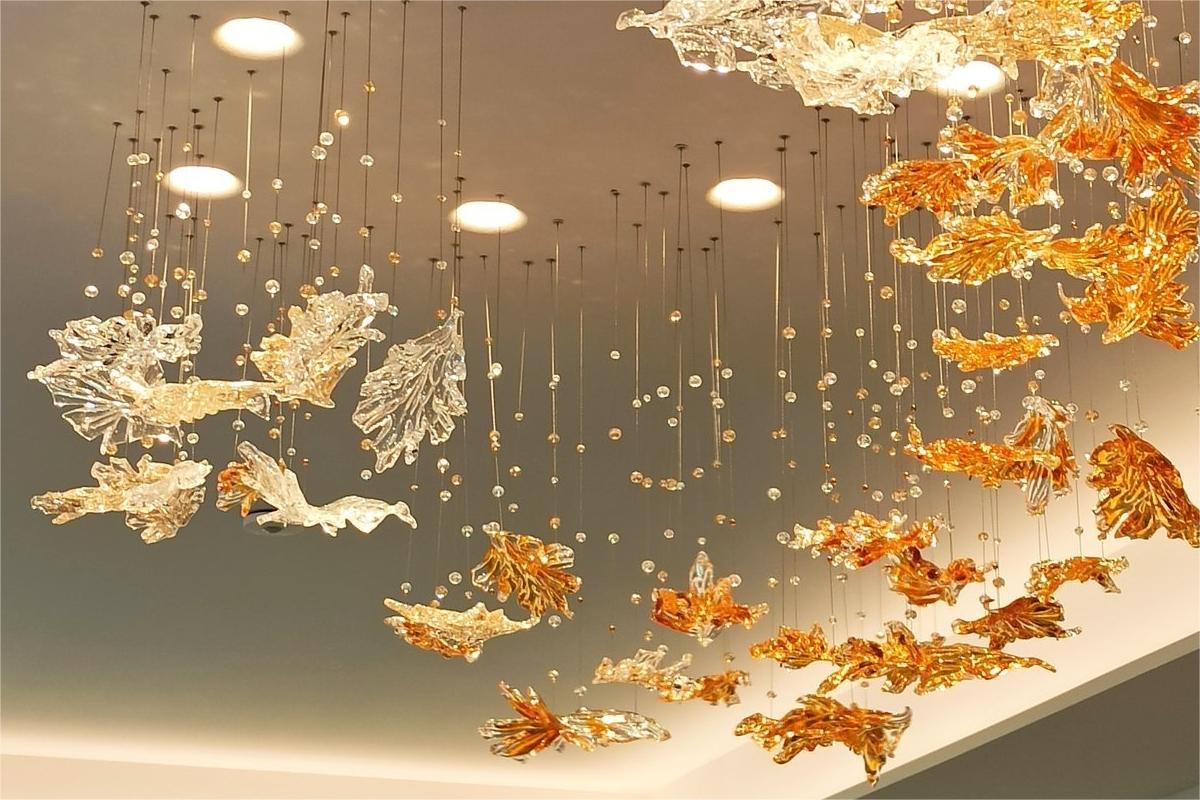Ⅰ Introduction
When elevating a room's ambiance, few components can rival a glass chandelier's stunning elegance and transforming ability. These gorgeous lighting fixtures have graced the ceilings of palaces, grand hotels, and opulent residences for ages, and their fascination shows no signs of abating. In this detailed guide, we'll delve into the world of glass chandeliers, from their rich history to practical care suggestions, and see how they can bring fresh life to any environment.
Ⅱ The Timeless Appeal of Glass Chandeliers
Glass chandeliers have a unique ability to collect and refract light, resulting in a captivating display that can instantly transform the atmosphere of a room. Their crystalline structure glows and shimmers, creating beautiful patterns on walls and ceilings and injecting a touch of elegance into even the most basic rooms. Whether you prefer the ornate decorations of traditional crystal chandeliers or the clean lines of modern glass interpretations, there is a style to suit every taste and interior design strategy.

The variety of glass chandeliers is quite impressive. While they are commonly associated with formal dining rooms and majestic entranceways, these magnificent fixtures may work wonderfully in unexpected places. Consider a little glass chandelier adding playfulness to a powder room or a cascading pattern as a focal point in a master bedroom. The options are unlimited, limited only by your imagination and the design of your area.
Ⅲ Choosing the Perfect Glass Chandelier
Choosing the perfect glass chandelier for your home is more than choosing a design you like. Consider the following elements to guarantee that your decision not only looks good but also operates well in your space:
1.Size and scale: The chandelier should be in proportion to the room and any furnishings beneath it. A typical rule of thumb is to add the room's length and width in feet and then convert that amount to inches to determine the optimal chandelier diameter.
2. Ceiling height: For spaces with high ceilings, choose chandeliers with numerous levels or longer drops to maximize vertical space.
3. Light output: Consider the room's primary use. A dining space may benefit from softer, more ambient lighting, but a living room may need brighter lighting for reading and other activities.
4. Style consistency: While differences might be visually appealing, make sure your chandelier compliments the overall aesthetic of your home for a unified look.
5. Glass type and quality: From hand-blown Murano glass to precision-cut crystal, the type and quality of glass used in your chandelier can have a considerable impact on both its appearance and cost.
Ⅳ Chandelier Lighting: Creating the Perfect Ambiance
The enchantment of a glass chandelier rests not just in its physical beauty, but also in how it interacts with light to create ambience. Chandelier lighting may be adjusted to create various moods and promote different activities throughout the day. Here are some suggestions for increasing the impact of your chandelier lighting:
- Dimmer switches: By installing a dimmer, you can easily control the intensity of the light, ranging from bright and useful to soft and romantic.
- Bulb selection: Try out several bulb kinds and color temperatures. Warm white bulbs (2700-3000K) provide a pleasant, inviting ambiance, whereas cooler tones (3500-4100K) might bring out the sparkle in the glass.
- Layered lighting: To create depth and versatility in your lighting scheme, combine your chandelier with various light sources such as wall sconces, table lamps, or recessed lighting.
- Reflective surfaces: Mirrors positioned strategically can reflect the light from your chandelier, making the space appear brighter and more expansive.
- Natural light interaction: Think about how sunlight will interact with your chandelier during the day. Positioning near windows can produce beautiful prismatic effects during the day.
Ⅴ How to Clean a Glass Chandelier: Maintaining the Sparkle
A well-kept glass chandelier can be a showpiece, but neglect can soon dull its shine. Regular cleaning is required to keep your chandelier looking its best. Here's a step-by-step method for cleaning a glass chandelier safely and effectively:
- Preparation: Turn the chandelier off and let it cool completely. Put a drop cloth or towel underneath to catch any drips.
- Dust removal: Using a soft, dry microfiber cloth or a feather duster, gently remove surface dust from the glass and frame.
- Solution preparation: Create a gentle cleaning solution by combining warm water and a few drops of mild dish soap. To achieve a streak-free shine on crystal chandeliers, use one part isopropyl alcohol and three parts distilled water.
- Cleaning procedure: Dampen a delicate cloth with cleaning solution and carefully wipe down each glass piece. Soft-bristled brushes or cotton swabs can be used to clean hard-to-reach spots.
- Drying: To avoid water spots, carefully dry each piece with a clean, lint-free cloth. To add glitter, polish the dry glass using a microfiber cloth.
- Bulb cleaning: While you're about it, carefully wipe the light bulbs with a moist cloth to eliminate dust and maximize light output.
Consider employing a professional cleaning service to guarantee that huge, intricate, or pricey chandeliers are cleaned securely and effectively.
Ⅵ Beyond the Basics: Innovative Glass Chandelier Designs
While traditional crystal chandeliers remain popular, contemporary designers are expanding the scope of what a glass chandelier may be. Glass chandeliers are more diverse and intriguing than ever, with abstract sculptural works that blur the line between illumination and art as well as eco-friendly designs that incorporate recycled glass.
Some innovative trends in glass chandelier design include:
- Organic forms: Chandeliers inspired by natural elements like trees, flowers, or water droplets.
- Mixed materials: Combinations of glass with metals, wood, or even fabric for unique textural contrasts.
- Smart technology: Integration of LED lighting and smart home systems for customizable color-changing capabilities and voice-activated control.
- Modular designs: Chandeliers that can be reconfigured or expanded to suit changing spaces or preferences.
- Sustainable production: Use of recycled glass and energy-efficient manufacturing processes to appeal to eco-conscious consumers.
To summarize, a glass chandelier is more than simply a light fixture; it's a statement piece that can completely shift the atmosphere of a room. Whether you prefer the timeless elegance of conventional designs or the cutting-edge appeal of modern interpretations, there is a glass chandelier out there to complement your taste and enrich your area. With careful selection, location, and maintenance, your chandelier will continue to amaze and delight for years to come, acting as a brilliant centerpiece in your home's design narrative.
Ⅶ FAQ
1. What is the difference between glass chandelier and crystal chandelier?
Crystal contains lead oxide, giving it more weight and refraction than ordinary glass. This indicates that crystal is more bright, shines more, and is prismatic. Lead oxide content is vital in crystal chandeliers, yet it is also safe for consumer health.
2. Is crystal more expensive than glass?
This is because it requires fewer materials to be manufactured, making it more economical for consumers. However, one of the reasons crystal is more expensive than glass is that it is viewed as more elegant and sophisticated. Its extra chemicals make it slightly porous, allowing it to refract light.
3. What type of lighting is a chandelier?
Chandeliers give ambient light. Ceiling. This style of fixture is directly mounted to the ceiling and features a glass or plastic shade that conceals the light bulb. Ceiling fixtures have been popular in homes for nearly a century, frequently supplying all of the ambient light in a space.

